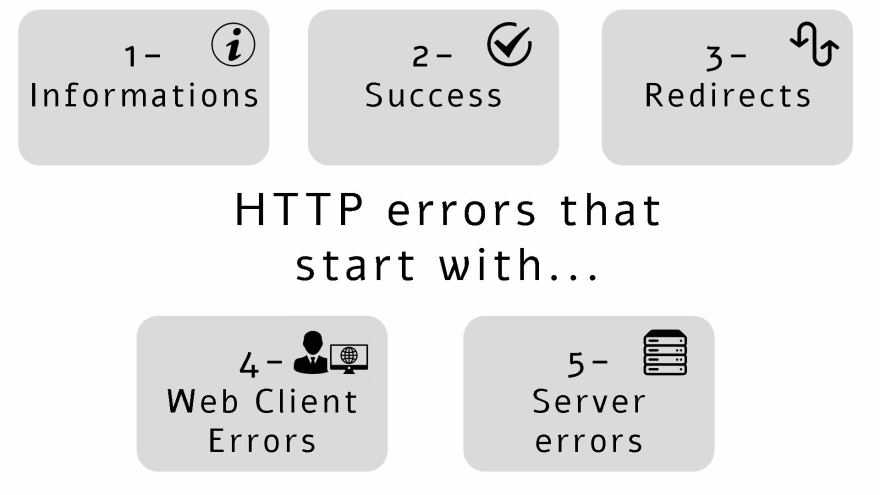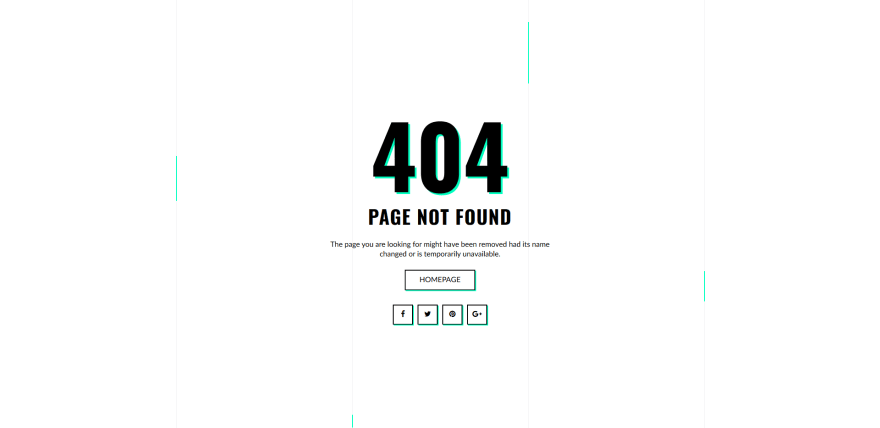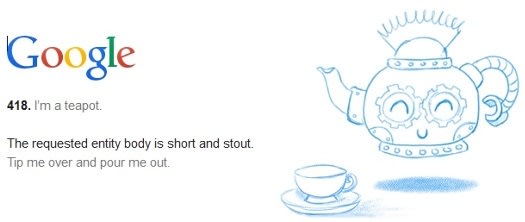An Interest In:
Web News this Week
- April 20, 2024
- April 19, 2024
- April 18, 2024
- April 17, 2024
- April 16, 2024
- April 15, 2024
- April 14, 2024
Why the 404 error ?
Hello everyone, today we're going to look at HTTP errors, you know like when you get a page not found with the 404 error. In reality there are almost a hundred different error codes. Don't worry, it's difficult to know them all by heart, but there are techniques to find out roughly where the error comes from. You are ready, so let's go !
Why did you invent these numbers ?
But then why did we invent these error numbers? The answer is actually quite simple, when a user requests a web page through his browser, the browser will send a request to the server under the world famous HTTP protocol. The server will also respond in HTTP format, and if all goes well will send the requested resource (in our case the web page). But everything gets complicated when there is an error. Knowing that there is an error is good, but knowing where is even better. This is why error numbers were quickly assigned to each different type of error. This is much more practical and saves time for many developers. For example, errors starting with 5 are problems at the server level.
The five categories of error
To simplify the whole thing, and to put some order in all these errors, categories have been created. There are three different categories:
1 - Informations
2 - Success
3 - Redirects
4 - Web client errors
5 - Server errors
So if an error number starts with 4, we know directly that the problem comes from the web client.
Why 404 error ?
But why 404 errors? If you have been following this, you will notice that the first number is a 4 and that the error comes directly from the web client and not from the server. Indeed, the 404 error means that the resource is not found, the server has searched for it on its side but has not found it, so the error comes from the web client which has not provided the right url.
Going further with error 418
The HTTP error 418 has nothing to do with the other errors. Indeed its meaning is "I'm a teapot". It is actually a joke since it first appeared in the famous RFC 2324 on April 1, 1998. The explanations given by the developers are: " There is coffee all over the world. Increasingly, in a world in which computing is ubiquitous, the computists want to make coffee. Coffee brewing is an art, but the distributed intelligence of the web- connected world transcends art. Thus, there is a strong, dark, rich requirement for a protocol designed expressly for the brewing of coffee. Coffee is brewed using coffee pots. Networked coffee pots require a control protocol if they are to be controlled".
In other words, the famous Hyper Text Coffee Pot Control Protocol, or HTCPCP, is intended to send an error back to all those who would like to control a coffee pot remotely, telling them that they have mistakenly addressed themselves to ... a teapot .
This April 1st "joke" had its heyday at the time and is still featured on a number of official links in which its error code has been preserved.
There are still people asking questions about this 418 error, even today!
Specific errors
For those who wish to find a specific error, you can refer to these different tables classified by categories.
Some codes are not yet in use, but are intended for future use. Other codes do not result in any specific display to the user, but are implied (e.g. codes 200 or 304, which are never seen by the client as they concern the majority of successful requests).
All major HTTP errors are represented in these different tables, of the different error types:
Codes beginning with 1 (Informations):
| Code | Message | Meaning |
|---|---|---|
| 100 | Continue | Waiting for the application to be processed. |
| 101 | Switching Protocols | Acceptance of the change of protocol. |
| 102 | Processing | Processing in progress (prevents the customer from exceeding the waiting time limit). |
| 103 | Early Hints | While waiting for the final response, the server returns links that the client can start downloading. |
Codes beginning with 2 (Success):
| Code | Message | Meaning |
|---|---|---|
| 200 | OK | Request successfully processed. The response will depend on the query method used. |
| 201 | Created | Request successfully processed and document created. |
| 202 | Accepted | Request processed, but no guarantee of result. |
| 203 | Non-Authoritative Information | Information returned, but generated by an uncertified source. |
| 204 | No Content | Request successfully processed but no information to return. |
| 205 | Reset Content | Request successfully processed, current page can be deleted. |
| 206 | Partial Content | Only part of the resource has been transmitted. |
| 207 | Multi-Status | Multiple answers.(WebDav) |
| 208 | Already Reported | The document was previously sent in this collection.(WebDav) |
| 210 | Content Different | The copy of the resource on the client side differs from that on the server (content or properties).(WebDav) |
| 226 | IM Used | The server has completed the request for the resource, and the response is a representation of the result of one or more instance manipulations applied to the current instance. |
Codes beginning with 3 (Redirects):
| Code | Message | Meaning |
|---|---|---|
| 300 | Multiple Choices | The requested URI refers to several resources. |
| 301 | Moved Permanently | Permanently moved document. |
| 302 | Found | Document moved temporarily. |
| 303 | See Other | The answer to this request lies elsewhere. |
| 304 | Not Modified | Document not modified since the last request. |
| 305 | Use Proxy (since HTTP/1.1) | The request must be re-addressed to the proxy. |
| 306 | Switch Proxy | Code used by an older version of RFC 26167, now reserved. It meant "The following requests must use the specified proxy ". |
| 307 | Temporary Redirect | The request must be temporarily redirected to the specified URI. |
| 308 | Permanent Redirect | The request must be permanently redirected to the specified URI. |
| 310 | Too many Redirects | The request has to be redirected too many times, or falls victim to a redirection loop. |
Codes beginning with 4 (Web client errors):
| Code | Message | Meaning |
|---|---|---|
| 400 | Bad Request | The syntax of the query is wrong. |
| 401 | Unauthorized | Authentication is required to access the resource. |
| 402 | Payment Required | Payment required to access the resource. |
| 403 | Forbidden | The server has understood the request, but refuses to execute it. Unlike the 401 error, authenticating will not make any difference. On servers where authentication is required, this usually means that authentication has been accepted but the access rights do not allow the client to access the resource. |
| 404 | Not Found | Resource not found. |
| 405 | Method Not Allowed | Unauthorised query method. |
| 406 | Not Acceptable | The requested resource is not available in a format that would respect the "Accept" headers of the request. |
| 407 | Proxy Authentication Required | Access to the resource allowed by identification with the proxy. |
| 408 | Request Time-out | The amount of time a request from the client has been waiting on the server side. According to the HTTP specification: "The client did not produce a request within the time the server was willing to wait. The client MAY repeat the request without modification at any later time ". |
| 409 | Conflict | The request cannot be processed at this time. |
| 410 | Gone | The resource is no longer available and no redirection address is known. |
| 411 | Length Required | The length of the request was not specified. |
| 412 | Precondition Failed | Preconditions sent by the request not checked. |
| 413 | Request Entity Too Large | Treatment abandoned due to too high a demand. |
| 414 | Request-URI Too Long | URI too long. |
| 415 | Unsupported Media Type | Unsupported query format for a given method and resource. |
| 416 | Requested range unsatisfiable | Incorrect "range" query header fields. |
| 417 | Expectation failed | Expected and defined behaviour in the header of the unsatisfactory request. |
| 418 | Im a teapot | "I am a teapot": This code is defined in RFC 232410 dated 1 April 1998, Hyper Text Coffee Pot Control Protocol. It is a webmaster's joke, intended to send an error back to anyone who wants to remotely control a coffee pot, telling them that they have mistakenly addressed a teapot :) |
| 421 | Bad mapping / Misdirected Request | The request has been sent to a server that is not capable of producing a response (for example, because a connection has been reused). |
| 422 | Unprocessable entity | The entity provided with the request is incomprehensible or incomplete.(WebDAV) |
| 423 | Locked | The operation cannot take place because the resource is locked.(WebDAV) |
| 424 | Method failure | A method in the transaction has failed.(WebDAV) |
| 425 | Too Early | The server cannot process the request as it may be replayed. |
| 426 | Upgrade Required | The client should change the protocol, for example to TLS/1.0. |
| 428 | Precondition Required | The request must be conditional. |
| 429 | Too Many Requests | The customer has made too many requests within a given time frame. |
| 431 | Request Header Fields Too Large | The HTTP headers sent exceed the maximum size allowed by the server. |
| 449 | Retry With | Code defined by Microsoft. The request should be returned after performing an action. |
| 450 | Blocked by Windows Parental Controls | Code set by Microsoft. This error occurs when Windows Parental Controls are enabled and block access to the page. |
| 451 | Unavailable For Legal Reasons | This error code indicates that the requested resource is inaccessible for legal reasons. |
| 456 | Unrecoverable Error | Unrecoverable error.(WebDAV) |
Codes beginning with 5 (Server errors):
| Code | Message | Meaning |
|---|---|---|
| 500 | Internal Server Error | Internal server error. |
| 501 | Not Implemented | Claimed functionality not supported by the server. |
| 502 | Bad Gateway ou Proxy Error | By acting as a proxy or gateway server, the server received an invalid response from the remote server. |
| 503 | Service Unavailable | Service temporarily unavailable or under maintenance. |
| 504 | Gateway Time-out | Time taken to wait for a response from a server to an intermediate server. |
| 505 | HTTP Version not supported | HTTP version not supported by the server. |
| 506 | Variant Also Negotiates | Negotiation error. |
| 507 | Insufficient storage | Insufficient space to edit properties or build the collection.(WebDAV) |
| 508 | Loop detected | Loop in a resource linkage.(WebDAV) |
| 509 | Bandwidth Limit Exceeded | Used by many servers to indicate a quota overrun. |
| 510 | Not extended | The request does not respect the extended HTTP resource access policy. |
| 511 | Network authentication required | The client must authenticate to access the network. Used by captive portals to redirect clients to the authentication page. |
I hope you have enjoyed this article. If you have any questions, feel free to ask me in the comments.
Original Link: https://dev.to/clementgaudiniere/why-404-error--1n89
Dev To
 An online community for sharing and discovering great ideas, having debates, and making friends
An online community for sharing and discovering great ideas, having debates, and making friendsMore About this Source Visit Dev To




